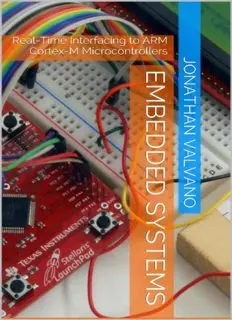Table Of ContentE M B E D D E D S Y S T E M S :
REAL-TIME INTERFACING TO ARM®
CORTEXTM-M MICROCONTROLLERS
Volume 2
Fourth Edition,
July 2014
Jonathan W. Valvano
Fourth edition
2nd Printing
July 2014
ARM and uVision are registered trademarks of ARM Limited.
Cortex and Keil are trademarks of ARM Limited.
Stellaris and Tiva are registered trademarks Texas Instruments.
Code Composer Studio is a trademark of Texas Instruments.
All other product or service names mentioned herein are the trademarks of their respective
owners.
In order to reduce costs, this college textbook has been self-published. For
more information about my classes, my research, and my books, see
http://users.ece.utexas.edu/~valvano/
For corrections and comments, please contact me at:
valvano@mail.utexas.edu. Please cite this book as: J. W. Valvano, Embedded
Systems: Real-Time Interfacing to ARM ® CortexTM-M Microcontrollers,
http://users.ece.utexas.edu/~valvano/, ISBN: 978-1463590154, 2014.
Copyright © 2014 Jonathan W. Valvano
All rights reserved. No part of this work covered by the copyright herein may
be reproduced, transmitted, stored, or used in any form or by any means
graphic, electronic, or mechanical, including but not limited to photocopying,
recording, scanning, digitizing, taping, web distribution, information
networks, or information storage and retrieval, except as permitted under
Section 107 or 108 of the 1976 United States Copyright Act, without the prior
written permission of the publisher.
ISBN-13: 978-1463590154
ISBN-10: 1463590156
Table of Contents
Preface to Third Edition
Preface to Fourth Edition
Preface
Acknowledgements
1. Introduction to Embedded Systems
1.1. Computer Architecture
1.2. Embedded Systems
1.3. The Design Process
1.4. Digital Logic and Open Collector
1.5. Digital Representation of Numbers
1.6. Ethics
1.7. Exercises
1.8. Lab Assignments
2. ARM Cortex-M Processor
2.1. CortexTM-M Architecture
2.2. Texas Instruments LM3S and TM4C I/O pins
2.3. ARM � CortexTM-M Assembly Language
2.4. Parallel I/O ports
2.5. Phase-Lock-Loop
2.6. SysTick Timer
2.7. Choosing a Microcontroller
2.8. Exercises
2.9. Lab Assignments
3. Software Design
3.1. Attitude
3.2. Quality Programming
3.3. Software Style Guidelines
3.4. Modular Software
3.5. Finite State Machines
3.6. Threads
3.7. First In First Out Queue
3.8. Memory Management and the Heap
3.9. Introduction to Debugging
3.10. Exercises
3.11. Lab Assignments
4. Hardware-Software Synchronization
4.1. Introduction
4.2. Timing
4.3. Petri Nets
4.4. Kahn Process Networks
4.5. Edge-triggered Interfacing
4.6. Configuring Digital Output Pins
4.7. Blind-cycle Interfacing
4.8. Busy-Wait Synchronization
4.9. UART Interface
4.10. Keyboard Interface
4.11. Exercises
4.12. Lab Assignments
5. Interrupt Synchronization
5.1. Multithreading
5.2. Interthread Communication and Synchronization
5.3. Critical Sections
5.4. NVIC on the ARM � Cortex-M Processor
5.5. Edge-triggered Interrupts
5.6. Interrupt-Driven UART
5.7. Periodic Interrupts using SysTick
5.8. Low-Power Design
5.9. Debugging Profile
5.10. Exercises
5.11. Lab Assignments
6. Time Interfacing
6.1. Input Capture or Input Edge Time Mode
6.2. Output Compare or Periodic Timer
6.3. Pulse Width Modulation
6.4. Frequency Measurement
6.5. Binary Actuators
6.6. Integral Control of a DC Motor
6.7. Exercises
6.8. Lab Assignments
7. Serial Interfacing
7.1. Introduction to Serial Communication
7.2. RS232 Interfacing
7.3. RS422/USB/RS423/RS485 Balanced Differential Lines
7.4. Logic Level Conversion
7.5. Synchronous Transmission and Receiving using the SSI
7.6. Inter-Integrated Circuit (I2C) Interface
7.7. Introduction to Universal Serial Bus (USB)
7.8. Exercises
7.9. Lab Assignments
8. Analog Interfacing
8.1. Resistors and Capacitors
8.2. Op Amps
8.3. Analog Filters
8.4. Digital to Analog Converters
8.5. Analog to Digital Converters
8.6. Exercises
8.7. Lab Assignments
9. System-Level Design
9.1. Design for Manufacturability
9.2. Power
9.3 Tolerance
9.4. Design for Testability
9.5. Printed Circuit Board Layout and Enclosures
9.6. Exercises
9.7. Lab Assignments
10. Data Acquisition Systems
10.1. Introduction
10.2. Transducers
10.3. Discrete Calculus
10.4. Data Acquisition System Design
10.5. Analysis of Noise
10.6. Data Acquisition Case Studies
10.7. Exercises
10.8. Lab Assignments
11. Introduction to Communication Systems
11.1. Fundamentals
11.2. Communication Systems Based on the UARTs
11.3. Wireless Communication
11.4. Internet of Things
11.5. Exercises
11.6. Lab Assignments
Appendix 1. Glossary
Appendix 2. Solutions to Checkpoints
Index
Reference Material
Preface to Third Edition
There are a new features added to this third edition. The new development platform based
on the TM4C123 is called Tiva LaunchPad. Material in this book on the TM4C also
applies to the LM4F because Texas Instruments rebranded the LM4F series as TM4C
(same chips new name), and rebranded StellarisWare™ as TivaWare™. These new
microcontrollers run at 80 MHz, include single-precision floating point, have two 12-bit
ADCs, and support DMA and USB. A wonderful feature of these new boards is their low
cost. As of December 2013, the boards are available on TI.com as part number EK-
TM4C123GXL for $12.99. They are also available from $13 to $24 at regular electronics
retailers like arrow.com, newark.com, mouser.com, and digikey.com. The book can be
used with either a LM3S or TM4C microcontroller. Although this edition now focuses on
the M4, the concepts still apply to the M3, and the web site associated with this book has
example projects based on the LM3S811, LM3S1968, and LM3S8962.
Preface to Fourth Edition
This fourth edition includes the new TM4C1294-based LaunchPad. Most of the code in
the book is specific for the TM4C123-based LaunchPad. However, the book website
includes corresponding example projects for the LM3S811, LM3S1968, LM4F120, and
TM4C1294, which are ARM ® Cortex™-M microcontrollers from Texas Instruments.
There are now two lost-cost development platforms called Tiva LaunchPad. The EK-
TM4C123GXL LaunchPad retails for $12.99, and the EK-TM4C1294XL Connected
LaunchPad retails for $19.99. The various LM3S, LM4F and TM4C microcontrollers are
quite similar, so this book along with the example code on the web can be used for any of
these microcontrollers. Compared to the TM4C123, the new TM4C1294 microcontroller
runs faster, has more RAM, has more ROM, includes Ethernet, and has more I/O pins.
This fourth edition switches the syntax from C to the industry-standard C99, adds a line-
tracking robot, designs an integral controller for a DC motor, and includes an expanded
section on wireless communication and Internet of Things.

